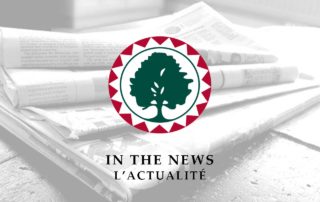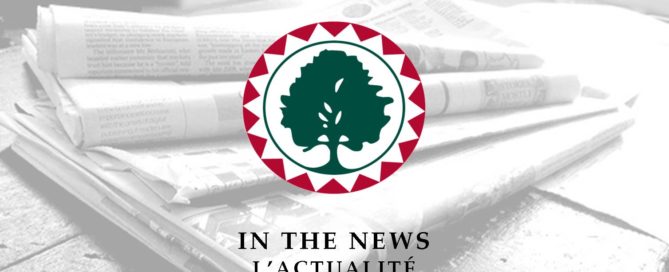-
FNTC: NEWS
In the news: Taxing First Nations promotes accountability, good governance
On May 19, 2017, Business in Vancouver published an article by Joseph Quesnel of the Fraser Institute on the benefits of taxation for First Nation governance. The following is an excerpt of the article:
Many indigenous communities consider tax exemption to be sacrosanct.
But other First Nations now realize that raising funds through taxation is essential to modern governance. Whitecap Dakota First Nation in Saskatchewan recently signed an agreement in principle to move toward even greater self-government. They are clear how they got there.
“We wouldn’t have the casino if we didn’t have our land code,” said Chief Darcy Bear. “We have a real property tax and a goods and services tax in our community. Like any government, we need to generate our own revenue. Getting out from under 25% of the Indian Act has allowed us to grow. Self-government will take us further.”
For more: https://www.biv.com/article/2017/5/taxing-first-nations-promotes-accountability-good-/
Tulo Student Profile: Gailene William
The Williams Lake Indian Band understands the importance of increasing source revenues as federal funding remains stagnant and even dwindles. Without additional funds, the band cannot grow or plan for the future. Own source revenue in the forms of taxation plays a vital role. In Williams Lake, Gailene William is taking on this role in addition to her job as the payroll/benefits administration clerk. Recently, we were able to sit down with Gailene and get her perspective on Tulo and Taxation.
How did you become enrolled in Tulo?
Our finance manager asked me if I was interested in taking the course at Tulo. Not really knowing what I was getting into, I dove right into the training without having any previous exposure to taxation but realized it would benefit me in my job and most of all, our community. I started in the fall of 2015, and took my final course in February 2017.
How does what you learned at the Tulo Centre help you in your work with Williams Lake Indian Band?
Many communities are beginning to realize taxation is the key to a better life. It isn’t something we should fear, but a way to create a better future. Managing taxation wisely for the nation requires education and practical training. To succeed, nations need a thorough knowledge of the ins and outs of the First Nation Fiscal Management Act and members who understand the band’s vision.
Being part of the Tulo experience has given me a broader outlook on the benefits of taxation and a properly running tax administration program and made me more confident in both the administration and education of taxation for WLIB.
What has been the most valuable aspect about the program for you so far?
Well the course work has been most valuable but thanks to Tulo a big part is that I now have contacts from other communities that I met in class who I can email or call for assistance and that’s really helped in creating my support network. Its allowed me to see what other communities are doing and learn from each other in addition to the time we spend in the class.
How does taxation fit into your community’s future?
I believe First Nation land taxation benefits a community and helps provide own source revenue – most communities financial planning is based on third-party funding agreements but when you also can add in other revenue, with no funding guidelines attached, you are able to look longer term. So in that essence, everyone benefits from it depending on how you budget your tax revenue. From opportunities for building new infrastructure to adding or enhancing programs and services that affect elders and youth, everyone benefits from tax revenue in our community. Tulo has been an excellent experience and it has also been a real challenge. “Introduction to First Nation Taxation” was the first exposure I’ve had to First Nation land taxation but attending Tulo has helped me greatly in all areas.
Also like many of our communities, at WLIB staff wear multiple hats and we also have our personal commitments to consider – for myself being a mom of three children I had a hard time leaving my kids for a week at a time for each of the eight classes. But thanks to some wonderful classmates and wonderful family who took care of my babies, I made it through each class and have made it through the end.
Public Policy Forum – Expanding the Circle
In February 2017, the Public Policy Forum held a one-day conference, “Expanding the Circle: What Reconciliation and Inclusive Economic Growth Can Mean for First Nations and Canada”. With approximately 150 delegates, the conference was co-hosted by the National Aboriginal Economic Development Board, the National Aboriginal Capital Corporation Association and Indigenous and Northern Affairs Canada.
FNTC’s Chief Commissioner C.T. (Manny) Jules appeared on a panel, “Taking Action for Reconciliation and Inclusive Economic Growth”, where he outlined his position for improving the numerous economic development challenges facing First Nations and how they can become part of the national economy.
This includes the creation of an institutional basis for First Nations to move forward. Chief Commissioner Jules discussed some of the initiatives the FNTC is working on with First Nations, including an infrastructure institute, a land title registry and an aboriginal resource tax.
Chief Commissioner Jules also spoke about the commitment by the federal government to create a new fiscal relationship with First Nations. However, he stated the relationship must not be based on program-based financial transfers, as the financial need will never be met. “I don’t want to create a situation where our governments are managing poverty, and that could happen as a result of a new program-based fiscal relationship. Our governments have to be able to manage wealth. They have to be able to set up standards to facilitate economic development growth. We have to own our own lands.”
Chief Commissioner Jules, in keeping with the theme of the segment of ‘taking action for reconciliation and inclusive economic growth’, said this means the work begins with First Nations.
“We, as Indigenous people, have to come up with the solutions. There’s no way that the federal government, provincial governments or indeed the municipal governments can come up with the solutions. This has to come from us.”
The Minister of Indigenous and Northern Affairs, the Honourable Carolyn Bennett, and the National Chief of the Assembly of First Nations, Perry Belgarde, addressed the delegates in separate presentations.
Later in the day, the keynote address was delivered by the Honourable Jody Wilson-Raybould, the Minister of Justice and Attorney General of Canada. Minister Wilson-Raybould outlined the federal government’s plan to review laws and policies related to Indigenous Peoples. A working group of ministers will be responsible for the review and will examine relevant federal laws, policies, and operational practices to help ensure the Crown is meeting its constitutional obligations with respect to Aboriginal and treaty rights; adhering to international human rights standards, including the United Nations Declaration on the Rights of Indigenous Peoples; and supporting the implementation of the Truth and Reconciliation Commission’s Calls to Action.
Minister Wilson-Raybould will chair the working group, which will be comprised of six ministers who have significant responsibilities for the relevant statutes and policies to be reviewed. The working group will first develop a workplan and set of principles, which will reflect an all-government approach that addresses all Indigenous Peoples. Minister Wilson-Raybould said First Nation-led institutions should play a key role in rebuilding the relationship with First Nations. “As we move forward, in my opinion, we also need to give more consideration to how we support Indigenous-controlled institutions that advance nation rebuilding, so that it is Indigenous peoples that govern these institutions with a vested interest in the outcome of the work they do and the decisions they make… I am also very well aware of the Fiscal Management Act and the importance of the initiatives to strengthen the ability of First Nations to raise revenues as well as borrow monies from the bond market and generally establish sound financial administration systems. The role of the First Nations Finance Authority, the Financial Management Board and the First Nations Tax Commission, are very critical. And in my opinion, there is a need to consider how we can support additional Indigenous institutions that support nation rebuilding.”
The working group will work with Indigenous leaders, youth, and experts on various legal and policy questions relating to Indigenous Peoples. At the conclusion of her remarks, and in keeping with the work of the working group, the Minister offered to meet with the Chairs of the FMA institutions in April.
The Canadian Property Tax Association – Bringing Together Professionals in Taxation
Clearing the Path recently spoke with Brian Dell, executive vice president of the CPTA, and asked him to inform our readers on the work of the CPTA.
I am delighted to have this opportunity to give the readers of Clearing the Path a bit of insight into the Canadian Property Tax Association (CPTA). Our organization has had the privilege of working with the First Nations Tax Commission (FNTC) for the last 10 years, providing commentary and support on FNTC legislative reform and implementation of property tax initiatives. Prior to formation of the FNTC, the CPTA worked closely with the former Indian Taxation Advisory Board.
The CPTA was founded in 1967 and “is a national organization providing a forum for the exchange of ideas and information relating to both commercial and industrial property tax issues arising across Canada”. The CPTA consists of four regional chapters being British Columbia, Ontario, Quebec and Eastern Canada, and Western. A Board of Directors oversees the membership and operations of the CPTA on a national level and provides guidance and support to the four Chapters, with each Chapter having its own Executive Committee. On a regional basis each Chapter brings its expertise to a diversity of issues in the area of property taxation, whether it be commentary on provincial legislative change or more localized assessment practices.
The constitution of the CPTA sets the aims and objectives of the organization as follows: to provide a forum and information exchange in the field of assessment and taxation of property to promote the equitable assessment of property tax purposes along sound and uniform lines to study existing and proposed legislation and make representations to Governments to perform such other functions as are consonant with the foregoing purposes.
Consistent with its objects, the focus of the CPTA is to advocate from the perspective of the taxpayer, keeping in mind recognition that revenues generated from a fair distribution of property tax across the entire assessment base are vital to the public need and good government. In furtherance of its objectives the CPTA draws from its diverse membership which includes in-house and external property tax consultants, assessors, appraisers, legal practitioners, and property tax officers within various public and private organizations.
The CPTA meets its objectives by bringing together various professionals in taxation through an open flow of information and knowledge relating to the property tax industry. Among the tools employed by the CPTA to keep its membership informed of current issues and developments are education seminars and a bi-monthly newsletter, Communication Update. In the fall of each year our members gather at a National Workshop for 3 days of learning seminars, and equally important, the opportunity to network with other experts from across Canada.
In addition, each Chapter organizes its own education seminars, breakfast or luncheon meetings, round table meetings or other functions to keep the membership connected and informed. The CPTA also takes an active role in consultation with government and participates in various adhoc stakeholder committees providing insight from the taxpayer’s point of view.
We at the CPTA understand the challenges associated with working in an environment were there are numerous diverging opinions, whether they are issue specific or of national reach. Elements of regional interests and local economy must often be balanced against global principles. As is often said, there is seldom one single right answer to any question, however through openness, transparency, an appropriate exchange of information, and mutual respect and professionalism, collectively we can strive to achieve the best answer concurrent with the times.
The FNTC has made strong progress towards fostering open, fair and transparent property taxation on first nation lands. The hallmarks of a healthy property tax regime, from a taxpayer’s perspective not only involves transparent legislative and regulatory processes, but also engages full disclosure of how an assessment has been prepared, the existence of an impartial and independent assessment review system, while all leading to the comfort that there exists in any local a fair distribution of tax burden.
The FNTC has made significant inroads in promoting a clear and discernible path for property taxation regimes on first nation lands. We at the CPTA look forward to forging the relationship between our organizations through continued and productive dialogue.
Brian Dell
Executive Vice President, CPTA
Profile: Commissioner Price
Community Profile: Tk’emlúps te Secwepemc
While TteS has many accomplishments, the visual crowning glory is undoubtedly the arbour. This magnificent structure seats 2,500 people and is home to one of the largest celebrations of Indigenous culture and heritage in Western Canada: the Kamloopa Pow Wow. Thousands of visitors witness the storytelling, song and dance in traditional regalia in this annual celebration. However, the pow wow holds special significance for Tk’emlúpsemc (Kamloops people). It celebrates their heritage, builds community, and teaches children traditions and values.
The first official Kamloopa Pow Wow in the arbour opened on the site in conjunction as part of the 1993 Canada Games. Canada Games athletes, dignitaries, tourists, locals, other First Nations and TteS community members joined together to celebrate the achievement. For many, it was the first public demonstration of their right to proudly celebrate their culture and heritage in a long time.
-
CLEARING THE PATH: NEWS & SUCCESS STORIES
In the news: Taxing First Nations promotes accountability, good governance
On May 19, 2017, Business in Vancouver published an article by Joseph Quesnel of the Fraser Institute on the benefits of taxation for First Nation governance. The following is an excerpt of the article:
Many indigenous communities consider tax exemption to be sacrosanct.
But other First Nations now realize that raising funds through taxation is essential to modern governance. Whitecap Dakota First Nation in Saskatchewan recently signed an agreement in principle to move toward even greater self-government. They are clear how they got there.
“We wouldn’t have the casino if we didn’t have our land code,” said Chief Darcy Bear. “We have a real property tax and a goods and services tax in our community. Like any government, we need to generate our own revenue. Getting out from under 25% of the Indian Act has allowed us to grow. Self-government will take us further.”
For more: https://www.biv.com/article/2017/5/taxing-first-nations-promotes-accountability-good-/
Tulo Student Profile: Gailene William
The Williams Lake Indian Band understands the importance of increasing source revenues as federal funding remains stagnant and even dwindles. Without additional funds, the band cannot grow or plan for the future. Own source revenue in the forms of taxation plays a vital role. In Williams Lake, Gailene William is taking on this role in addition to her job as the payroll/benefits administration clerk. Recently, we were able to sit down with Gailene and get her perspective on Tulo and Taxation.
How did you become enrolled in Tulo?
Our finance manager asked me if I was interested in taking the course at Tulo. Not really knowing what I was getting into, I dove right into the training without having any previous exposure to taxation but realized it would benefit me in my job and most of all, our community. I started in the fall of 2015, and took my final course in February 2017.
How does what you learned at the Tulo Centre help you in your work with Williams Lake Indian Band?
Many communities are beginning to realize taxation is the key to a better life. It isn’t something we should fear, but a way to create a better future. Managing taxation wisely for the nation requires education and practical training. To succeed, nations need a thorough knowledge of the ins and outs of the First Nation Fiscal Management Act and members who understand the band’s vision.
Being part of the Tulo experience has given me a broader outlook on the benefits of taxation and a properly running tax administration program and made me more confident in both the administration and education of taxation for WLIB.
What has been the most valuable aspect about the program for you so far?
Well the course work has been most valuable but thanks to Tulo a big part is that I now have contacts from other communities that I met in class who I can email or call for assistance and that’s really helped in creating my support network. Its allowed me to see what other communities are doing and learn from each other in addition to the time we spend in the class.
How does taxation fit into your community’s future?
I believe First Nation land taxation benefits a community and helps provide own source revenue – most communities financial planning is based on third-party funding agreements but when you also can add in other revenue, with no funding guidelines attached, you are able to look longer term. So in that essence, everyone benefits from it depending on how you budget your tax revenue. From opportunities for building new infrastructure to adding or enhancing programs and services that affect elders and youth, everyone benefits from tax revenue in our community. Tulo has been an excellent experience and it has also been a real challenge. “Introduction to First Nation Taxation” was the first exposure I’ve had to First Nation land taxation but attending Tulo has helped me greatly in all areas.
Also like many of our communities, at WLIB staff wear multiple hats and we also have our personal commitments to consider – for myself being a mom of three children I had a hard time leaving my kids for a week at a time for each of the eight classes. But thanks to some wonderful classmates and wonderful family who took care of my babies, I made it through each class and have made it through the end.
Public Policy Forum – Expanding the Circle
In February 2017, the Public Policy Forum held a one-day conference, “Expanding the Circle: What Reconciliation and Inclusive Economic Growth Can Mean for First Nations and Canada”. With approximately 150 delegates, the conference was co-hosted by the National Aboriginal Economic Development Board, the National Aboriginal Capital Corporation Association and Indigenous and Northern Affairs Canada.
FNTC’s Chief Commissioner C.T. (Manny) Jules appeared on a panel, “Taking Action for Reconciliation and Inclusive Economic Growth”, where he outlined his position for improving the numerous economic development challenges facing First Nations and how they can become part of the national economy.
This includes the creation of an institutional basis for First Nations to move forward. Chief Commissioner Jules discussed some of the initiatives the FNTC is working on with First Nations, including an infrastructure institute, a land title registry and an aboriginal resource tax.
Chief Commissioner Jules also spoke about the commitment by the federal government to create a new fiscal relationship with First Nations. However, he stated the relationship must not be based on program-based financial transfers, as the financial need will never be met. “I don’t want to create a situation where our governments are managing poverty, and that could happen as a result of a new program-based fiscal relationship. Our governments have to be able to manage wealth. They have to be able to set up standards to facilitate economic development growth. We have to own our own lands.”
Chief Commissioner Jules, in keeping with the theme of the segment of ‘taking action for reconciliation and inclusive economic growth’, said this means the work begins with First Nations.
“We, as Indigenous people, have to come up with the solutions. There’s no way that the federal government, provincial governments or indeed the municipal governments can come up with the solutions. This has to come from us.”
The Minister of Indigenous and Northern Affairs, the Honourable Carolyn Bennett, and the National Chief of the Assembly of First Nations, Perry Belgarde, addressed the delegates in separate presentations.
Later in the day, the keynote address was delivered by the Honourable Jody Wilson-Raybould, the Minister of Justice and Attorney General of Canada. Minister Wilson-Raybould outlined the federal government’s plan to review laws and policies related to Indigenous Peoples. A working group of ministers will be responsible for the review and will examine relevant federal laws, policies, and operational practices to help ensure the Crown is meeting its constitutional obligations with respect to Aboriginal and treaty rights; adhering to international human rights standards, including the United Nations Declaration on the Rights of Indigenous Peoples; and supporting the implementation of the Truth and Reconciliation Commission’s Calls to Action.
Minister Wilson-Raybould will chair the working group, which will be comprised of six ministers who have significant responsibilities for the relevant statutes and policies to be reviewed. The working group will first develop a workplan and set of principles, which will reflect an all-government approach that addresses all Indigenous Peoples. Minister Wilson-Raybould said First Nation-led institutions should play a key role in rebuilding the relationship with First Nations. “As we move forward, in my opinion, we also need to give more consideration to how we support Indigenous-controlled institutions that advance nation rebuilding, so that it is Indigenous peoples that govern these institutions with a vested interest in the outcome of the work they do and the decisions they make… I am also very well aware of the Fiscal Management Act and the importance of the initiatives to strengthen the ability of First Nations to raise revenues as well as borrow monies from the bond market and generally establish sound financial administration systems. The role of the First Nations Finance Authority, the Financial Management Board and the First Nations Tax Commission, are very critical. And in my opinion, there is a need to consider how we can support additional Indigenous institutions that support nation rebuilding.”
The working group will work with Indigenous leaders, youth, and experts on various legal and policy questions relating to Indigenous Peoples. At the conclusion of her remarks, and in keeping with the work of the working group, the Minister offered to meet with the Chairs of the FMA institutions in April.
The Canadian Property Tax Association – Bringing Together Professionals in Taxation
Clearing the Path recently spoke with Brian Dell, executive vice president of the CPTA, and asked him to inform our readers on the work of the CPTA.
I am delighted to have this opportunity to give the readers of Clearing the Path a bit of insight into the Canadian Property Tax Association (CPTA). Our organization has had the privilege of working with the First Nations Tax Commission (FNTC) for the last 10 years, providing commentary and support on FNTC legislative reform and implementation of property tax initiatives. Prior to formation of the FNTC, the CPTA worked closely with the former Indian Taxation Advisory Board.
The CPTA was founded in 1967 and “is a national organization providing a forum for the exchange of ideas and information relating to both commercial and industrial property tax issues arising across Canada”. The CPTA consists of four regional chapters being British Columbia, Ontario, Quebec and Eastern Canada, and Western. A Board of Directors oversees the membership and operations of the CPTA on a national level and provides guidance and support to the four Chapters, with each Chapter having its own Executive Committee. On a regional basis each Chapter brings its expertise to a diversity of issues in the area of property taxation, whether it be commentary on provincial legislative change or more localized assessment practices.
The constitution of the CPTA sets the aims and objectives of the organization as follows: to provide a forum and information exchange in the field of assessment and taxation of property to promote the equitable assessment of property tax purposes along sound and uniform lines to study existing and proposed legislation and make representations to Governments to perform such other functions as are consonant with the foregoing purposes.
Consistent with its objects, the focus of the CPTA is to advocate from the perspective of the taxpayer, keeping in mind recognition that revenues generated from a fair distribution of property tax across the entire assessment base are vital to the public need and good government. In furtherance of its objectives the CPTA draws from its diverse membership which includes in-house and external property tax consultants, assessors, appraisers, legal practitioners, and property tax officers within various public and private organizations.
The CPTA meets its objectives by bringing together various professionals in taxation through an open flow of information and knowledge relating to the property tax industry. Among the tools employed by the CPTA to keep its membership informed of current issues and developments are education seminars and a bi-monthly newsletter, Communication Update. In the fall of each year our members gather at a National Workshop for 3 days of learning seminars, and equally important, the opportunity to network with other experts from across Canada.
In addition, each Chapter organizes its own education seminars, breakfast or luncheon meetings, round table meetings or other functions to keep the membership connected and informed. The CPTA also takes an active role in consultation with government and participates in various adhoc stakeholder committees providing insight from the taxpayer’s point of view.
We at the CPTA understand the challenges associated with working in an environment were there are numerous diverging opinions, whether they are issue specific or of national reach. Elements of regional interests and local economy must often be balanced against global principles. As is often said, there is seldom one single right answer to any question, however through openness, transparency, an appropriate exchange of information, and mutual respect and professionalism, collectively we can strive to achieve the best answer concurrent with the times.
The FNTC has made strong progress towards fostering open, fair and transparent property taxation on first nation lands. The hallmarks of a healthy property tax regime, from a taxpayer’s perspective not only involves transparent legislative and regulatory processes, but also engages full disclosure of how an assessment has been prepared, the existence of an impartial and independent assessment review system, while all leading to the comfort that there exists in any local a fair distribution of tax burden.
The FNTC has made significant inroads in promoting a clear and discernible path for property taxation regimes on first nation lands. We at the CPTA look forward to forging the relationship between our organizations through continued and productive dialogue.
Brian Dell
Executive Vice President, CPTA
Profile: Commissioner Price
Community Profile: Tk’emlúps te Secwepemc
While TteS has many accomplishments, the visual crowning glory is undoubtedly the arbour. This magnificent structure seats 2,500 people and is home to one of the largest celebrations of Indigenous culture and heritage in Western Canada: the Kamloopa Pow Wow. Thousands of visitors witness the storytelling, song and dance in traditional regalia in this annual celebration. However, the pow wow holds special significance for Tk’emlúpsemc (Kamloops people). It celebrates their heritage, builds community, and teaches children traditions and values.
The first official Kamloopa Pow Wow in the arbour opened on the site in conjunction as part of the 1993 Canada Games. Canada Games athletes, dignitaries, tourists, locals, other First Nations and TteS community members joined together to celebrate the achievement. For many, it was the first public demonstration of their right to proudly celebrate their culture and heritage in a long time.






